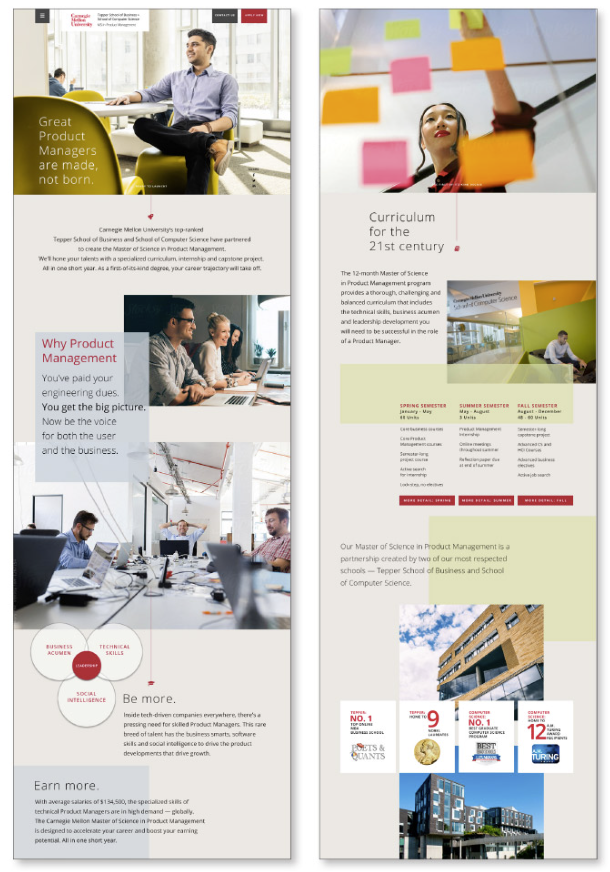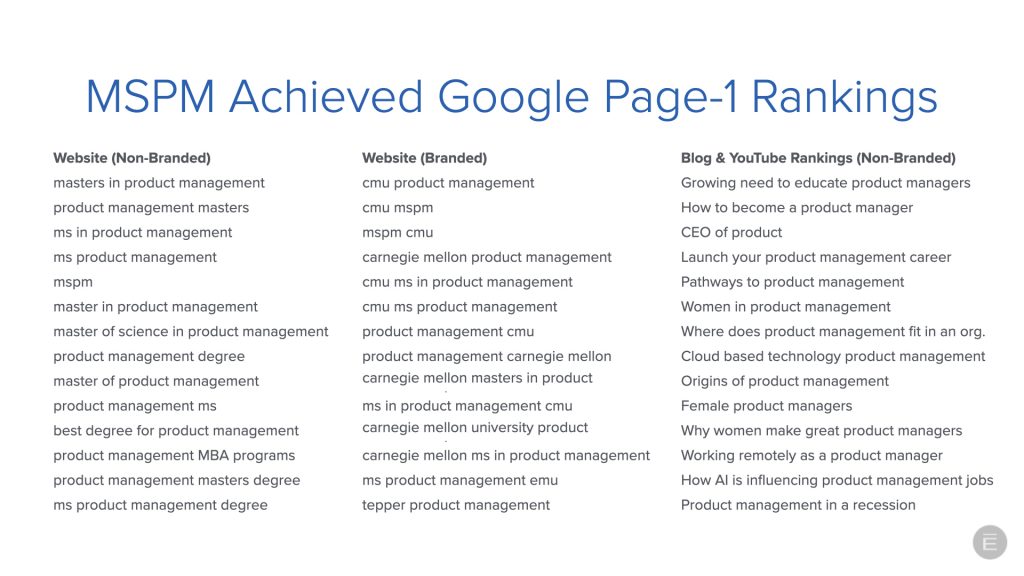| Mar 28, 2025
Increasing Enrollment for Masters Programs: Strategies, Tactics, Best Practices and Case Studies

The world is changing fast, and higher education is no exception. In the past decade, masters degrees had become the new bachelors. With new headwinds, there are is a move away from doctorates towards masters programs. The market isn’t just inching toward master’s programs—it’s now surging. Professionals are doubling down on specialized skills, and universities that recognize this aren’t just adapting; they’re leading. The question isn’t if master’s programs will dominate—it’s who will build the most compelling, transformative experiences for the next generation of leaders.
Having grown enrollment in more than 25 masters programs in the past two decades, here is what we have learned:
Strategies, Tactics and Best Practices
1. Inform website, microsite, landing page and ad creative by research about student behavior and what they value. When we reflected GMAC research findings into Carnegie Mellon’s MS in information systems management program microsite and ad creative, its applications grew by 118 percent within one year.
2. Tell a better story. Romance prospects and show that the value of the degree exceeds its cost. Carnegie Mellon MSE degree was ranked on Google page one for every conceivable keyword, but its enrollment was still anemic. With a photoshoot of rock star students, and new copy that emphasized value of the degree, the enrollment took off without additional marketing.
3. Fish where the fish are. Since digital now leads traditional media, promote your program on digital channels like web, Google, social and Wikipedia. When we helped William Woods transition its marketing budget from all traditional to primarily digital, its masters enrollment grew by 25 percent and online enrollment doubled in just two years.
4. Pursue right-fit. Hunt like sharks and don’t feed like whales. Create personas with their unique motivations, be it career development, salary bump or living more meaningful lives. Increase your presence across their unique student journeys. We helped Carlow University achieve the highest enrollment in a decade by creating marketing that resonated with their right-fit ambitious underdog students at each stage of their student journey.
5. Persuade influencers. It is well known that the recommendations of bosses carry an extraordinary weight in the enrollment decisions of their followers. When William Woods masters educational program leaders fostered conversations with their 600+ alumni principals, school superintendents and education district leaders, the teachers signed up in droves for their MEd degrees.
6. Dominate Google, ChatGPT, Perplexity and Gemini page one because if your program can’t be found, it can’t be in the consideration set. Tune social to amplify storytelling. This is the secret of success of each and every one of our clients. For example, with top Google rankings, Pepperdine masters business programs grew dramatically and Carnegie Mellon MS in Product Management enrollment grew 12X in 4 years.
7. Lean into inquiry follow up strategies. Unlike undergraduate programs, maseters students expect the program directors and faculty to reach out and discuss the passion of students for their program.
8. A/B test your way to success. Effective A/B testing lets you quickly determine the difference between winning and losing messages, ad channels and geographies. Armed with these insights, we encourage our client to feed the winners and starve the losers. For Manchester Business School Global MBA program, we targeted 20 cities and deployed rapid A/B testing which quickly revealed that only 3 cities were converting. We pulled the budgets from the 17 non-performing cities and applied that to the 3 top converting cities. Their inquiries and applications grew rapidly.
9. Simplify application, acceptance and financial assistance forms and processes. You should be easy to do business with and your processes should not be an obstacle course. We’ve helped streamline processes for each and every one of our clients improving their applications yield and reducing their melt.
10. Engage alumni by featuring them and telling their stories of achievements. It will inspire confidence in prospective students. Prospective students connect with the alumni seeking their counsel and advice on whether they should enroll. We use this heuristic for all our higher education clients.
11. Forge partnerships with employers because they are not only harvesting grounds for new students, but also for projects and research initiatives. When we created corporate relations microsites and brochures for several Carnegie Mellon masters programs, they were handsomely rewarded with increased corporate engagement and sponsorships.
12. Cultivate feeders like undergrad programs and employers. When we encouraged a number of program chairs to cement ties with various national and international undergrad programs and HR/training manager at corporations, their enrollment grew dramatically.
Case Study: Carnegie Mellon MS in Product Management
Carnegie Mellon University’s (CMU) former Dean of the School of Computer Science had recently left Google. One of the challenges he faced there was the difficulty in finding seasoned product managers. The few product managers he was able to hire had risen through the ranks from marketing and software development. They had acquired the necessary customer experience and management skills on the job. He knew there was growing demand for product managers but no school was offering a masters degree in product management.
Armed with this insight, he designed the world’s first MS in Product Management program tapping talented professors from CMU’s top-ranked computer science and business schools.
Carnegie Mellon launched the program with an arcane belief that “if you build it, they will come”. That’s not what happened. After the program almost faltered, it turned to Elliance.
Elliance assessment was as follows: CMU is selling a premium product and asking prospects to make a $160K-$180K decision: $68K for tuition, $25K for room & board, and the $70K-$90K salary they would forgo to enroll in this program. For someone to make this expensive decision, we’ll need to romance them with a “Ferrari-looking” microsite and a thought-leadership blog. We recommend that CMU invest more money to market the new program with smart, micro-targeted paid media. Our initial goal will be to generate 300 leads of which 20 or so will convert into an enviable class for the second year. This initial investment will generate a pipeline of prospects for subsequent years. We added one more condition: “These students will trust you because you are a product manager. You’ll personally follow up with the leads in the first year.”
Carnegie Mellon liked our assessment and we got started.
Step 1: Build a “Ferrari” Microsite
We persuaded Carnegie Mellon to allow us to build the microsite outside the rigid grid of the institutional website template system. We created this masterpiece:

Step 2: Create a Story Landing Page
Since paid advertising prospects don’t have the patience to experience an expanded microsite, we built a story landing page that distilled our argument and told a compelling brand story. This was in sharp contrast to the industry best practices where prospects are served a skinny landing page with an intrusive inquiry form.

Step 3: Start a Thought Leadership Blog
Being one of the pioneering product management degrees, we recommended CMU claim their thought leadership position with a blog. Each blog post became a keyword hive to secure Google page one rankings for the program globally.

Over the next few years, we created several infographics, downloadable pdf’s, thought leader interviews, professional recognition awards and videos. Below is one of the videos we created to introduce the program:
Step 4: Launch a Paid Advertising Campaign
Elliance launched a smart, micro-targeted and machine-learning-based paid advertising campaign using various paid channels.
Step 5: Wait for the Inquiries and Applications
Right-fit prospects raised their hands. In the first year, close to 500 leads were generated from professionals working in blue-chip companies. The program director called every one of them. He learned a ton from those conversations and shared his insights with us. In turn, we fine-tuned and optimized our marketing messages and blog posts. The leads and applications continued to grow.
Step 6: Enjoy the Success
At the end of our first year, the enrollment grew five fold and at the end of four years it had grown 12 folds. Everyone was ecstatic. Carnegie Mellon raised the program tuition from $68K to $70K.
Google page one rankings for the website and the blog grew steadily. Here is a sample screen shot of some of their rankings at the end of the fourth year.

The key lessons we learned from this experience were that colleges should be prepared to break away from conventions. That if you are offering a premium degree, marketing should be proportionately elevated. That success is a byproduct of a productive partnership between the agency and client team. That the agency and clients teams must learn fast, adapt fast and move fast to claim a leadership position. That leadership belongs to the bold.
Contact us if you are seeking a smart higher education marketing agency which can help you join the legendary ranks of Carnegie Mellon’s MS in Product Management and increase enrollment in your graduate program.
